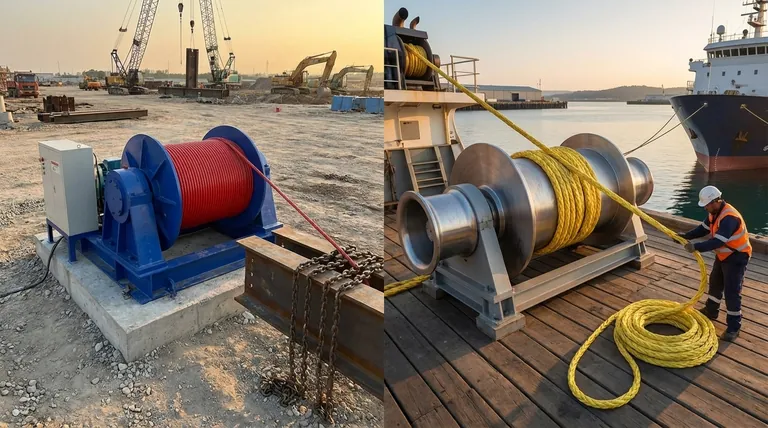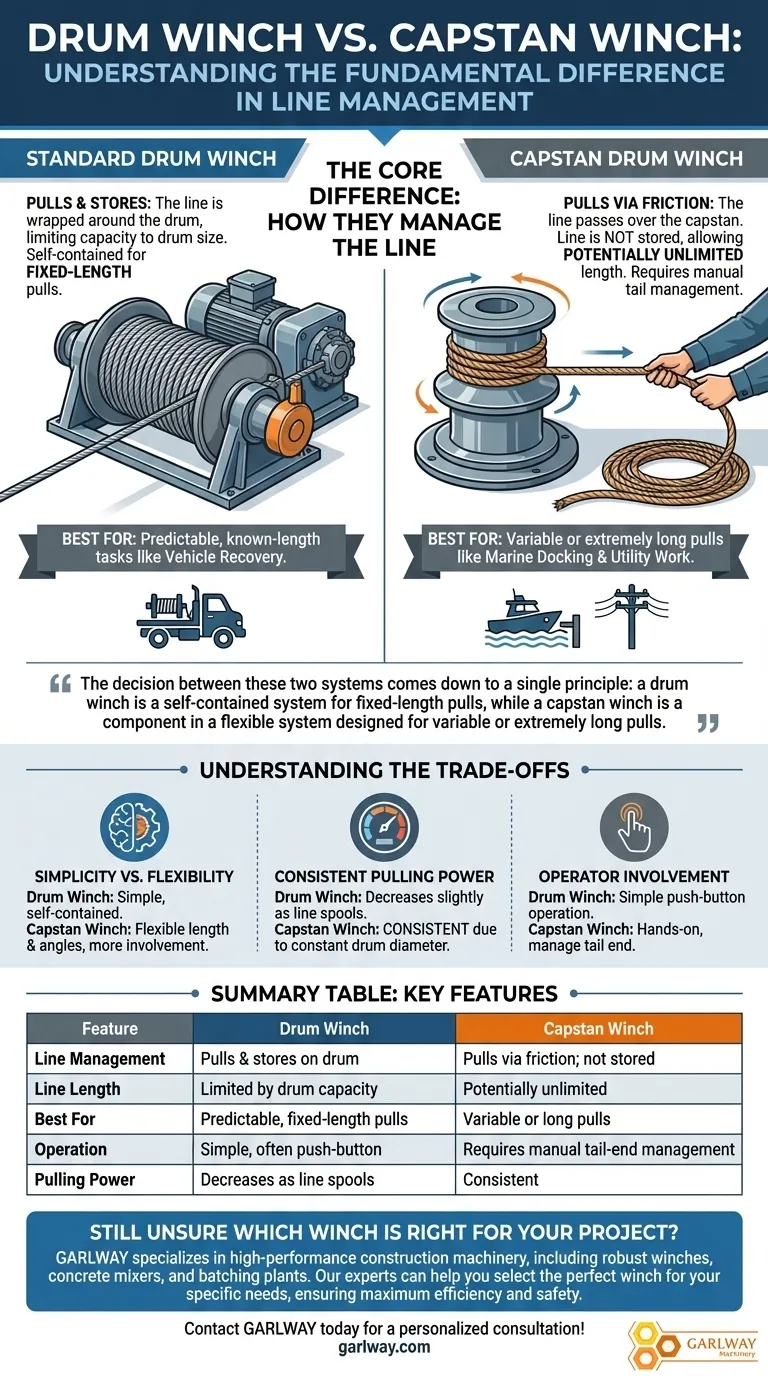The fundamental difference between a drum winch and a capstan winch is how they manage the line (rope or cable). A standard drum winch both pulls and stores the line on its drum, limiting its capacity to the drum's physical size. A capstan winch uses its drum purely for pulling via friction; the line is not stored on it, which allows for a potentially unlimited pulling length.
The decision between these two systems comes down to a single principle: a drum winch is a self-contained system for fixed-length pulls, while a capstan winch is a component in a flexible system designed for variable or extremely long pulls.

How a Standard Drum Winch Works
The All-in-One Design
A standard drum winch is an integrated system. Its core components—typically a motor, gearbox, and brake—are mounted together with a large drum.
Pulling and Storing in a Single Action
When you operate the winch, the motor turns the drum, which wraps the rope or cable around itself. This single action both pulls the load and stores the line.
The Inherent Limitation
The total length of the line is fixed by the physical capacity of the drum. You cannot use a longer rope than the drum can hold, making it ideal for predictable tasks like vehicle recovery where the required length is known.
How a Capstan Drum Winch Works
A System of Friction
A capstan winch also has a rotating drum, but its purpose is different. The line is wrapped around the capstan drum a few times, and the friction generated between the line and the rotating drum is what provides the pulling force.
Separating Pulling from Storing
The capstan only pulls the line; it does not store it. As the line is pulled through, an operator must manually pull on the "tail" end of the line to maintain tension and coil it for separate storage.
Unlimited Rope Length
Because the line simply passes over the capstan, its length is not limited by the winch itself. You can use a rope of any length, making it highly versatile for applications like marine docking or utility work where pulling distances can vary dramatically.
Understanding the Trade-offs
Simplicity vs. Flexibility
The standard drum winch is a model of simplicity. It's a self-contained unit that is easy to install and operate for a single purpose. The capstan winch offers immense flexibility in rope length and pulling angles but requires more user involvement and a separate plan for line storage.
Consistent Pulling Power
A capstan winch provides a more consistent pulling force. This is because the diameter of the drum remains constant. On a standard drum winch, the pulling power actually decreases slightly as more line is spooled onto the drum, increasing its effective diameter.
Operator Involvement
Operating a drum winch is often as simple as pressing a button. A capstan winch is a more hands-on system that requires an operator to manage the tail end of the line to maintain tension and safely store the rope as it comes off the drum.
Making the Right Choice for Your Application
The right winch depends entirely on the task you need to accomplish.
- If your primary focus is vehicle recovery or predictable, fixed-distance pulls: A standard drum winch is the superior choice for its self-contained design and ease of use.
- If your primary focus is marine applications, utility work, or tasks requiring very long or variable rope lengths: A capstan winch provides the essential flexibility that a drum winch cannot match.
Ultimately, choosing the correct winch begins with understanding how you need to manage your line.
Summary Table:
| Feature | Drum Winch | Capstan Winch |
|---|---|---|
| Line Management | Pulls and stores line on the drum | Pulls line via friction; line is not stored |
| Line Length | Limited by drum capacity | Potentially unlimited |
| Best For | Predictable, fixed-length pulls (e.g., vehicle recovery) | Variable or long pulls (e.g., marine, utility work) |
| Operation | Simple, often push-button | Requires manual tail-end line management |
| Pulling Power | Decreases slightly as line spools on | Consistent |
Still unsure which winch is right for your project?
GARLWAY specializes in high-performance construction machinery, including robust winches, concrete mixers, and batching plants. Our experts can help you select the perfect winch for your specific needs, ensuring maximum efficiency and safety for your construction company or contracting business.
Contact GARLWAY today for a personalized consultation and get the right pulling power on your job site!
Visual Guide

Related Products
- Best 18000 Pound Drum Anchor Trailer Winch
- Ready Mixer Machine for Construction Ready Mix Machinery
- Electric and Hydraulic Winch for Heavy Duty Applications
- Commercial Construction Mixer Machine for Soil Cement Mixing Concrete
- Warn Winch Windlass Boat Trailer Winch
People Also Ask
- What factors should be considered when choosing a trailer winch? Ensure Safe & Efficient Load Handling
- What is a trailer winch used for? Achieve Safe, Effortless Heavy Load Transport
- What is the significance of trailer winches in the boating industry? Ensure Safe and Efficient Boat Recovery
- How does using a trailer mounted winch reduce the need for additional equipment? Streamline Your Job Site Logistics
- What is the primary function of trailer winches? Effortlessly Load Heavy Boats & Equipment



















